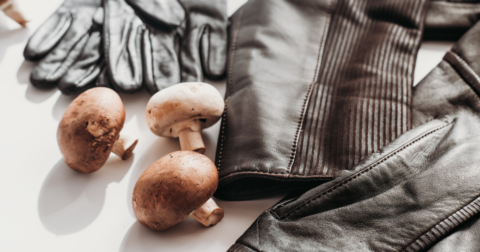Reported
Dairy Digesters Presented At Congressional Briefing As a Solution to Curbing Methane Emissions
Climate•6 min read
Explainer
Demand for cruelty-free leather alternatives are on the rise, along with a growing interest in materials that are better for the planet.


Words by Jessica Scott-Reid
The vegan leather market has boomed in recent years, reaching a global value of $39.5 billion in 2022, and a projected value of $74.5 billion by 2030. A growing consumer market is seeking animal-free leather alternatives, and for all sorts of reasons, including ethical and environmental concerns. As a result, an abundance of vegan leather manufacturers and brands have come onto the market with products created from a variety of materials.
But are all vegan leathers created equal? Let’s take a look at what vegan leather can be made of, and whether it’s really better for the planet.
Currently, the most common material used to make vegan leather is polyurethane, also called PU. This alternative material is a type of plastic that is touted for its versatility, durability and reduced environmental impact as compared to animal-based leather.
That said, the sustainability of PU is hotly debated. Its impact to the planet varies by how it’s made and thrown away — including production methods, applications and disposal. Some PU materials are made from fossil fuels, while others can be bio-based or acquired from renewable sources. And while traditional PU materials are often not easily recyclable or biodegradable, according to ethical fashion advocates Collective Fashion Justice, PU can also be made from recycled sources, “which assists with reducing waste and making use of already available resources.”
Collection Fashion Justice is a non-profit organization that has partnered with the United Nations, and advises manufacturers on sustainable practices. The group provides research and education to “illuminate the interlinked injustices in fashion supply chains and transition to a fashion system that upholds total ethics.” The group has published an extensive report series on leather, detailing the industry’s impact on animals, people and the planet.
Ultimately, when compared to animal-based leather, which requires farming and slaughtering animals and tanning skins (rendering them unable to biodegrade, even when vegetable-based tanning is used) Collective Fashion Justice concludes that PU can be considered less environmentally harmful.
Even so, to satisfy a consumer base seeking more sustainable vegan leather options, a number of companies have started working with other, plant-based materials, including cork, pineapple, mushroom, corn, coconut and cactus, to produce versatile and eco-friendly textiles.
Cork leather is crafted from the bark of cork oak trees. It is harvested every 9-12 years without harming the tree, and the bark then regenerates. Not cutting down the tree, notes Collective Fashion Justice, “helps the trees sequester more carbon.” Cork material is lightweight, water-resistant, durable and soft. It resists mold, mildew, and stains and is completely biodegradable.
Pineapple leather is derived from by-product pineapple leaf fibers that would otherwise go to waste. The fibers are then typically coated with a water-based PU resin, which can be biodegradable in certain settings. The brand Piñtatex has become widely available, and is used by brands such as H&M and Hugo Boss.
Mushroom leather brands, like Mylo, originate from mycelium, the root structure of mushrooms. “The mycelium is grown in vertical, indoor farms in a matter of days,” explains Collective Fashion Justice, “as opposed to years in the case of cattle,” and requires far less water and land. Mushroom leather is biodegradable, versatile and durable. Mylo has partnered with brands like Stella McCartney and Lulu Lemon to create exclusive products.
Corn leather is derived from corn waste and often used in conjunction with other animal-free materials. For example, YUMI Leather, “is made from 40% corn wastes extracted from industrial corn processing such as corn oil. The remainder of the components consist of recycled and virgin polyester and nylon,” according to Hong Kong vegan retailer O.N.E. Brands such as LØCI and Veja currently sell shoes made with corn waste and other materials.
Coconut leathers are made from coconut husks or coconut water, both of which are considered waste products. One brand, Malai Eco, is based in India. It manufactures a leather-like material from the water of mature coconuts, which it ferments into a jelly that is added to natural fibers, gums, resins and oils to produce the material called Malai.
Cactus leather is mainly made from cacti grown in Mexico, “where its makers support natural biodiversity,” writes Collective Fashion Justice, adding, “No trees have been cut down for the plantation.” The end result is a leather like material that is uniquely breathable. Mercedes Benz includes cactus leather (and Mylo) in the interior of its VISION EQXX electric car.
A common myth about animal-derived leather is that it’s a harmless byproduct of meat production, a way to make animal agriculture more sustainable by using skins rather than throwing them out. Yet because animal leather brings in substantial profit all its own, and is responsible for its own environmental harms, ethical fashion advocates and researchers argue that it is better described as a co-product of the meat industry.
Animal agriculture as a whole is responsible for at least 14.5 percent of global greenhouse gas emissions, as well as freshwater pollution, biodiversity loss, ocean degradation and deforestation. But animal leather production in particular is directly related to the destruction of the Amazon rainforest, making up more than a quarter of the value of the Brazilian cattle trade and the most valuable sector of the region’s cattle industry.
What’s more, the process of tanning animal skins involves the use of toxic chemicals, such as chromium, generating hazardous waste and pollution and impacting ecosystems and waterways.
As an alternative to animal-derived leather, vegan leathers benefit both the planet and the animals by sidestepping the extensive natural resources required to farm animals, cutting water use and greenhouse gas emissions. Plus, vegan leathers are made without animal suffering, or slaughter.
There are however some downsides to vegan leather, including varying degrees of quality and durability, along with accessibility and cost. For example, Veja’s corn waste leather shoes can run over $150, while Stella McCartney’s mushroom leather handbag, touted as the first-ever luxury bag crafted from mycelium, costs around $3,000. Clothes, shoes and accessories made with Piñatex appear more widely available and at a wider range of price points.
PU-based products, like those made by brand Matt & Nat (which also uses recycled water bottles as the base of their bag liners), are the most widely available and tend to be the most economical. Though again, the sustainability of PU varies by brand, specifically how each product is made, and whether it can be recycled or biodegrade in the near future.
Demand for vegan leather continues to rise — as does the push for more biodegradable and sustainable materials. As developers make better use of innovative and sustainable options, as well as technological advances in manufacturing and plant-based alternatives, the space will see a wider selection of plant-based leathers on the market. And as vegan leathers become more durable, the industry will continue to expand, with hopes of providing more versatile cruelty-free alternatives.